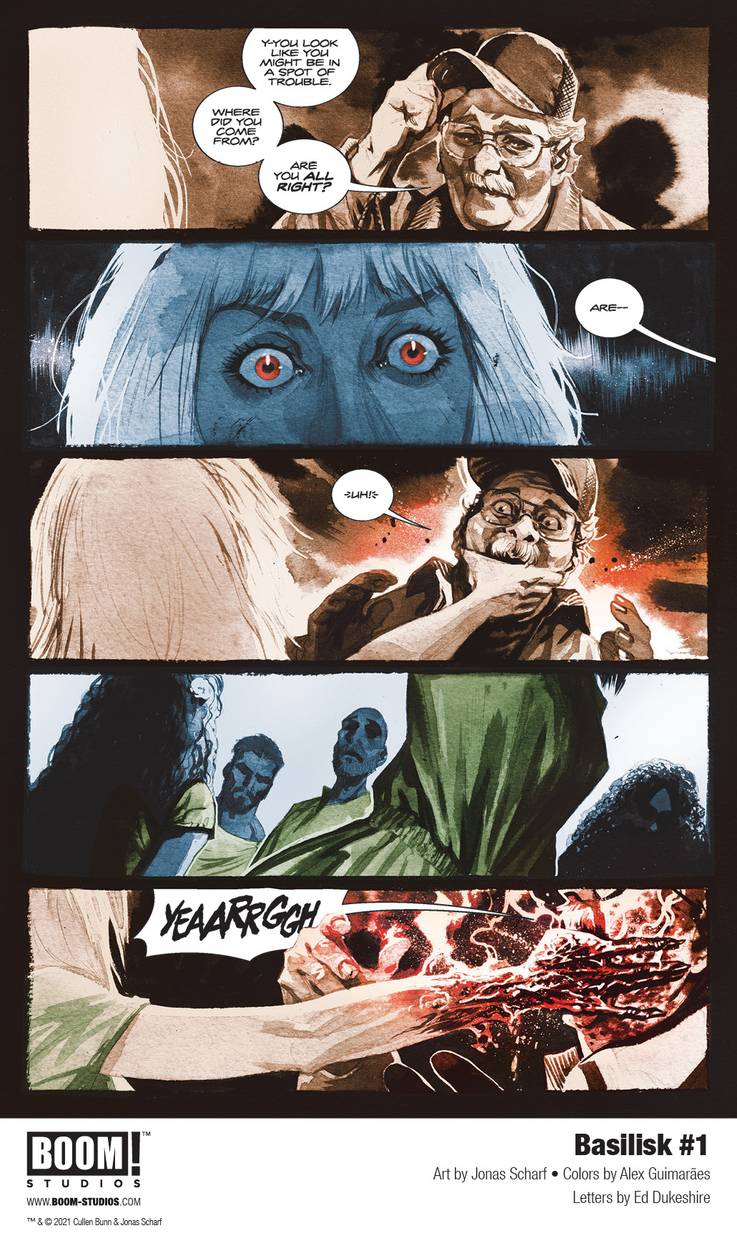Writer: Cullen Bunn
Artists: Jonas Scharf, Alex Guimarães
Boom! Comics, 2021
POTENT SYMBOLS EASILY JUMP boundaries to arrive at a different context, attaching to other contents in a jolt of recognition. Simple emblems like a circle within a circle continue to mystify me.

This perspective crept over me during the spectacle of horror in BASILISK in the first seven issues. The plot involves natural forces as personalities, avatars, an old device to test moral outcomes when gods come to Earth and do what they like, in this case with a band of five regular-looking people cast like waifs into the world with no memory before they arrived, at least none we know yet, each representing a human sense associated with extreme powers, and each an individual yet united, a chimera they call it.
Maybe not a chimera. I am not really sure what the chimera is yet, which is appropriate to a chimera, and the god-people themselves appear uncertain of what they know and think together, so they quickly fall out once the slaughter of whole communities of human beings begins in batches assisted by a cult of human followers. A woman who lost her family in one of these early episodes hunts them with the help of one of their number she kidnapped and who chose to stay, empowered with blazing eyes of righteousness.

Each issue starts with a duo-tone flashback as if recollected by one of the characters, filling in how we got here a bit at a time. The pace set by author Cullen Bunn is clearly attached to emotional conditions of the characters. People fill the foreground, especially faces in fine detail by illustrator Jonas Scharf, embedded in scenery cloaked in warm twilight colors by Alex Guimarães.

Real-life horror enters the story as the artist’s gaze looks around while the heroine and her mysterious partner drive in a car on a narrow road through a forest. Maybe you have seen it, too, when around a bend you encounter a roadkill with a giant vulture attached to the thing’s innards by its long bald head, who then startled rises up on giant wings bigger than your car to charge into the sky, blackening your windshield for an instant. The artist stops here for a close-up.
Crow profiles are also favored. Armies of crows witness everything.
The god-people appear to have no motive but to establish themselves. They are not mindless killers, nor mindful killers for a big purpose; just being themselves is lethal for people around them.
As the bodies mounted, the unleashed passions familiar in each of us in our own senses magnified, turned into a mirror of massacres I keep encountering in the bloody history of the world, the most recent a report by Russian scientist Yuri Orlov on a workers strike in 1962 in Novocherkassk (near Rostov on the lower Don River east of Crimea, where Ukrainian factions are fighting today). People of the city, women and children came out to witness the workers waving flags while marching and singing. Troops and tanks were called in to seal off the protesters, who walked through the tanks and “plugged the vision slits with clothing.” When they occupied strategic municipal buildings, the troops armed with Kalashnikov automatic rifles were ordered to fire. The tankers remained silent.
“All night long the fire brigades washed blood off the street.”
Immersed in Basilisk, some vision like this is inevitable as you come up for air gasping. Flickering images of murder and desolation multiply and numb the senses. Then I plunged directly over a waterfall-edge to a second view, unimagined and more horrible, present and immediate here and now as we fall, not baked into the past but baked into the future. Basilisk warns to count the dead anew.

Pacific Ocean coastal waters off Oregon and Washington are at risk of becoming dead zones, a reporter for local paper Street Roots in Portland informed us in a recent issue (Piper McDaniel, Feb. 16–22, 2022), quoting from government and academic reports. Lack of oxygen, acidity, and temperature are key factors. Conditions had “turned parts of the seafloor off Oregon into a carpet of dead Dungeness crabs and rotting sea worms … Virtually all of the fish appear to have fled the area.”
Global warming plays a part in this apocalypse on the coastal shelf, but a large part is due to toxic pesticide runoff from residential and commercial users, meaning many of you dorking around in your day-to-day lives keeping grass green. Monsanto’s Roundup was only this year outlawed in the USA, though the company is free to ship the poison to other countries under its new family name with Bayer corporation, just like poisons in the past (see Monsanto-Bayer story by Mitchel Cohen at CovertAction Magazine online).
Massive slaughter and extinction of life around us is a fact for us now and in the future as we move along willy nilly, not by ill will nor because we want it, but just because we are who we are and want what we want; unless one Basilisk heroine with a different mind and a little help can break our thralldom. When I left, danger was coming, and she was wounded and not yet out of the woods. Sounds bloody familiar.

